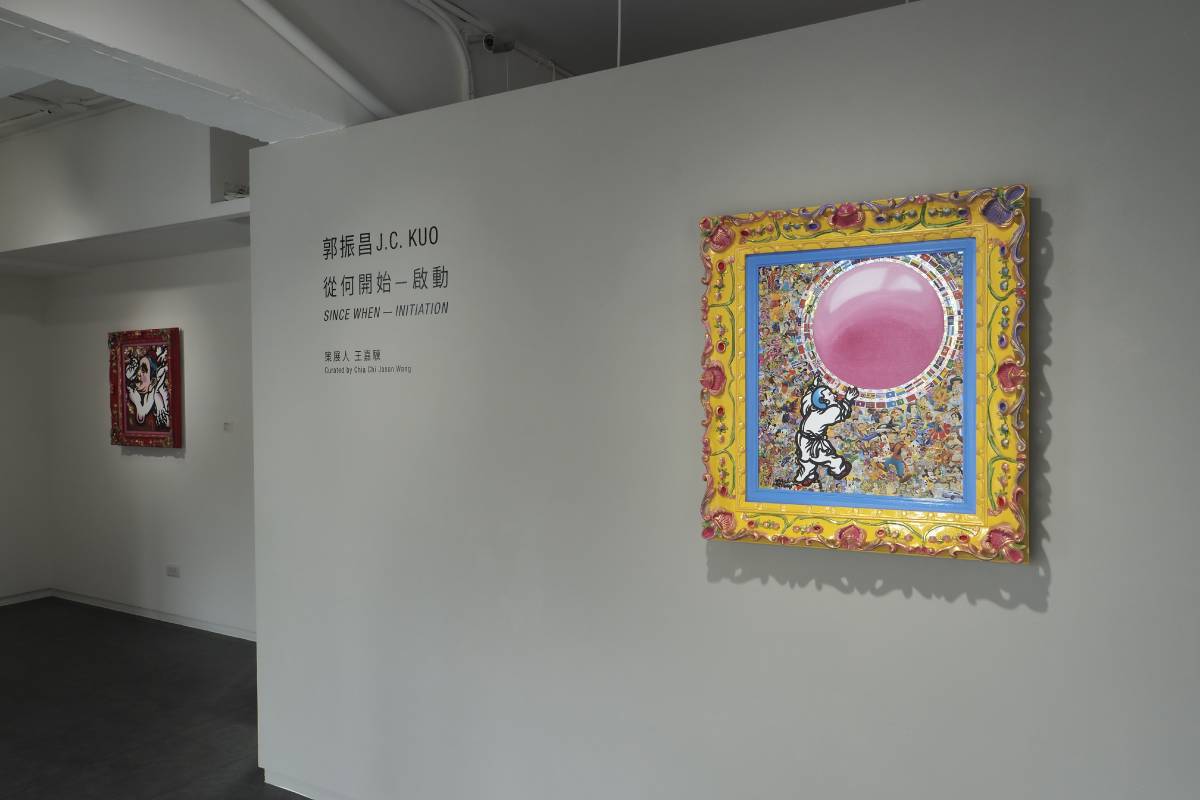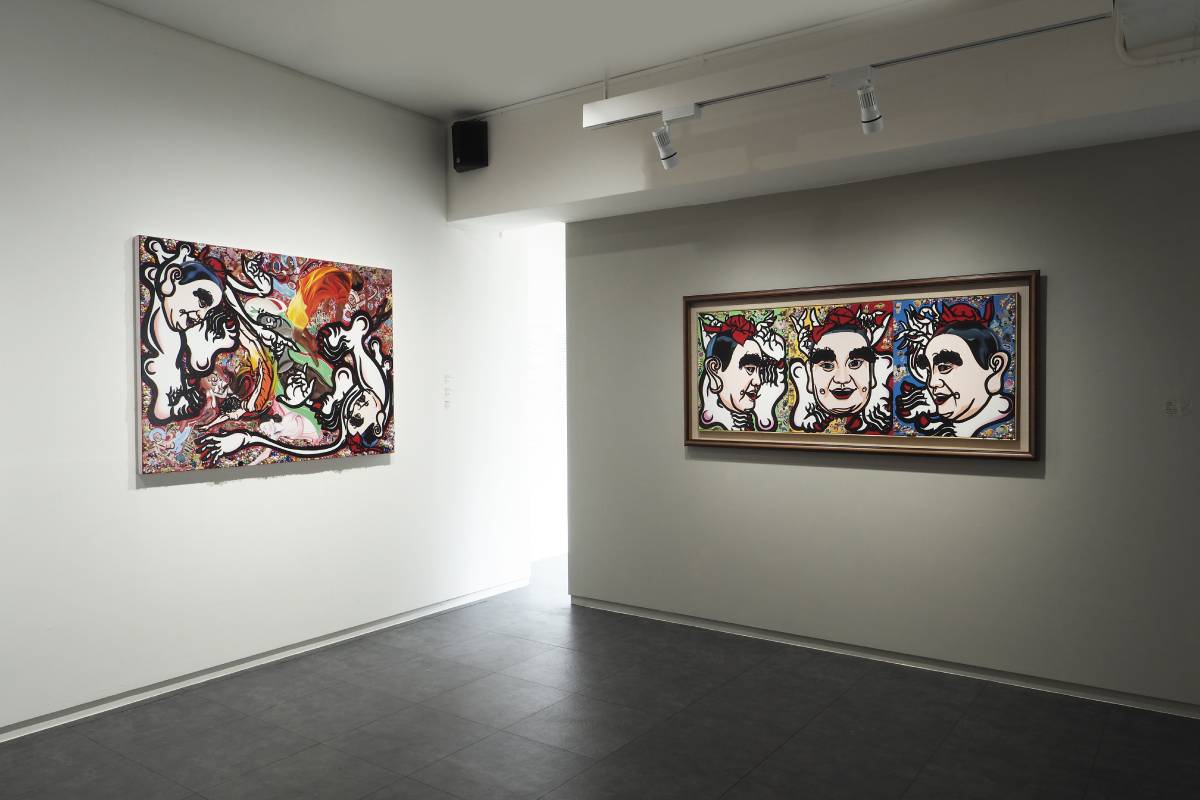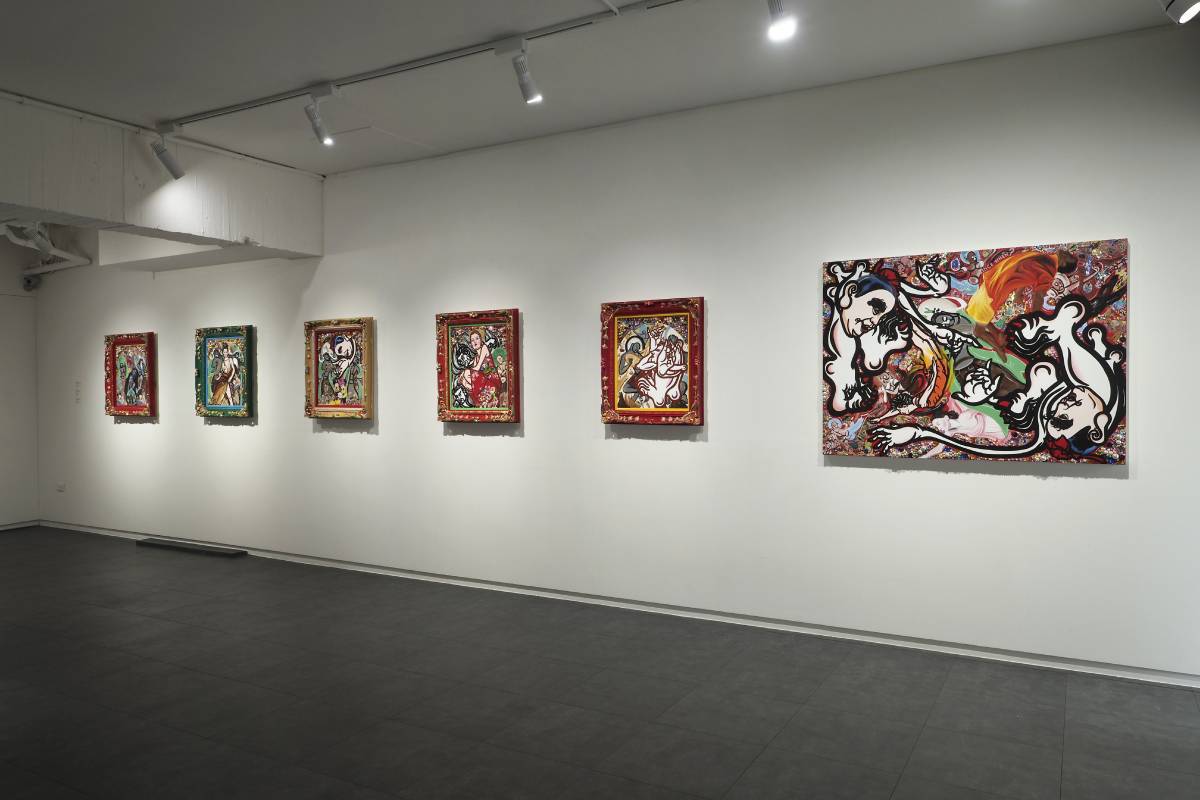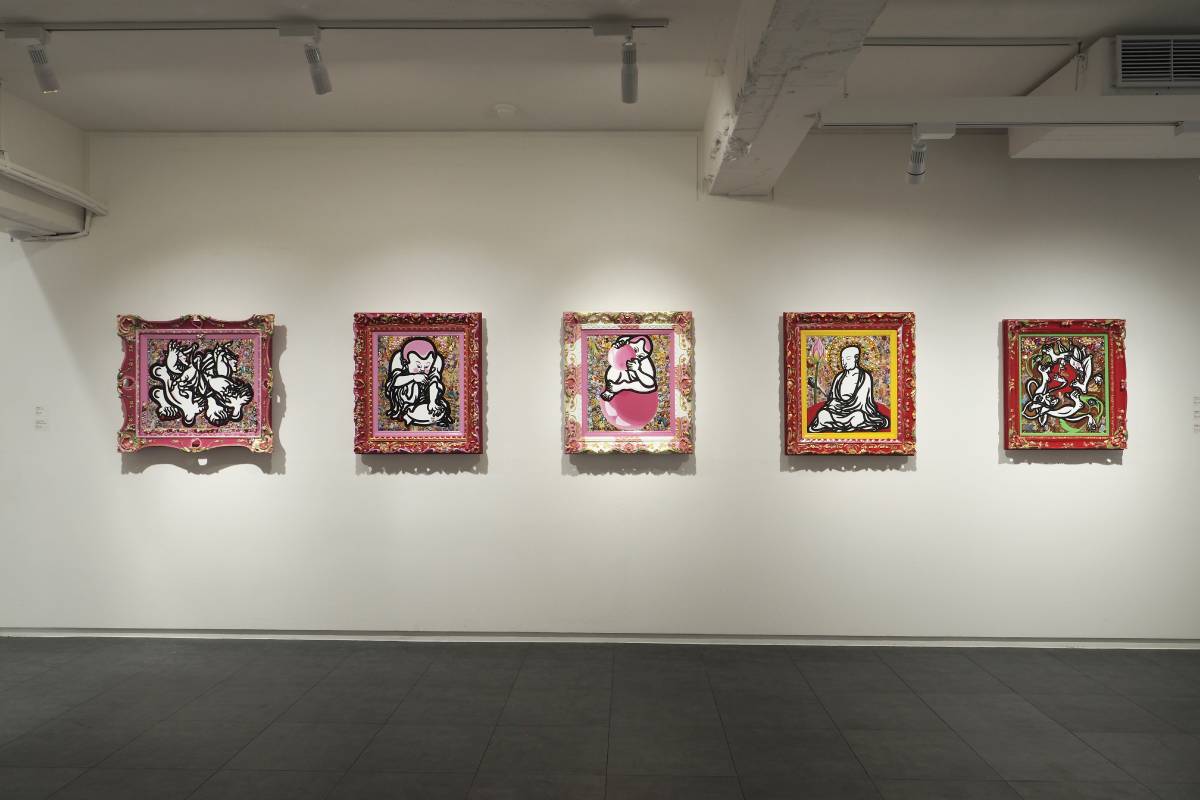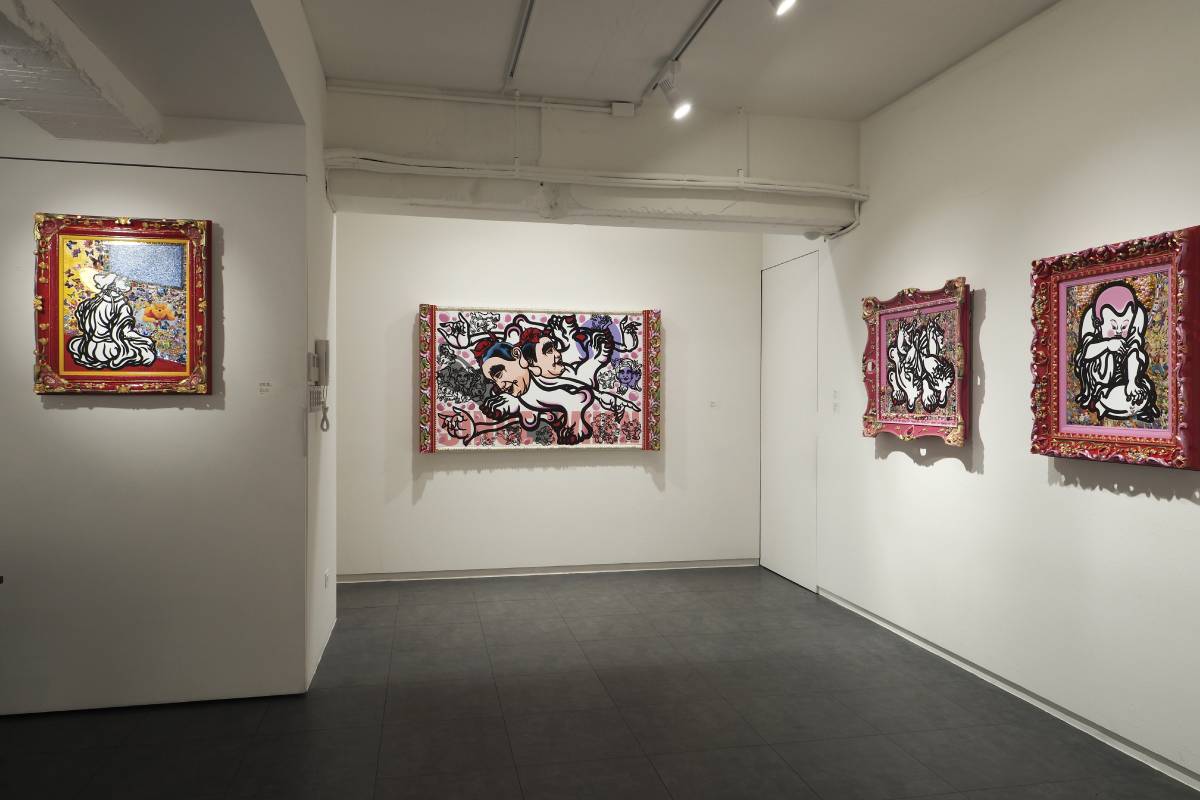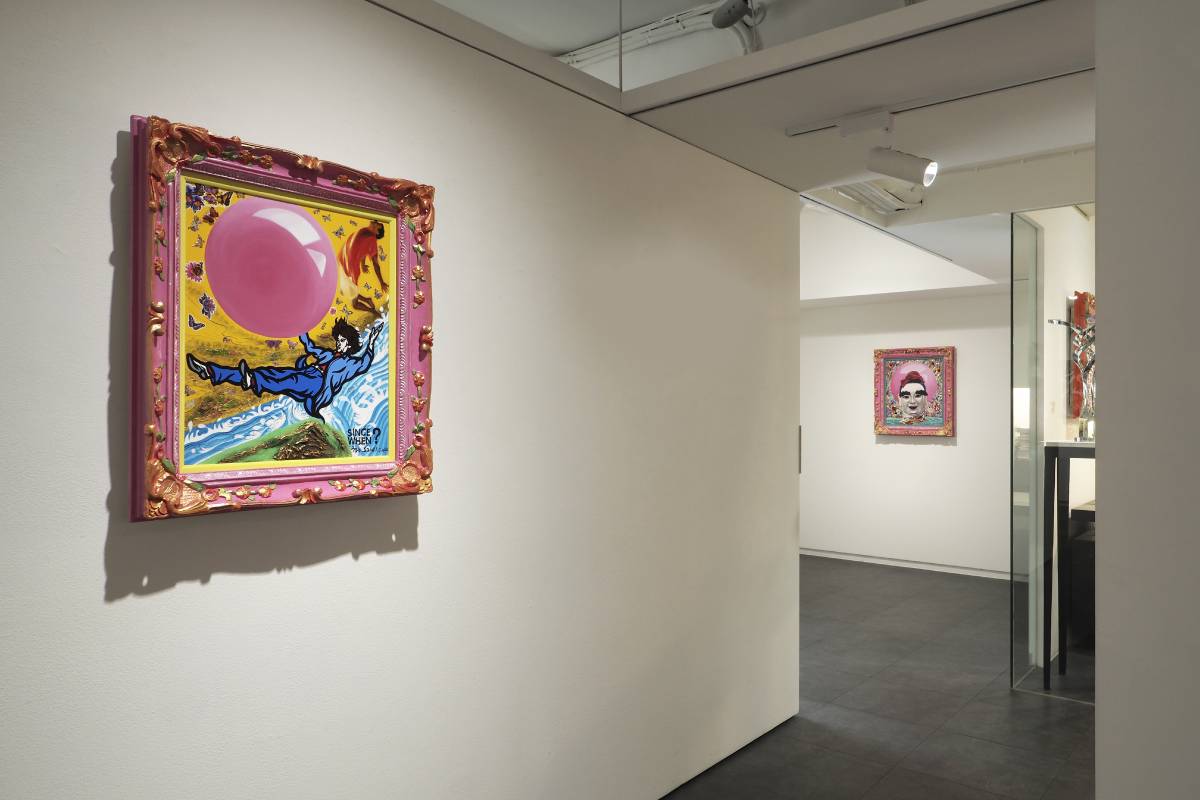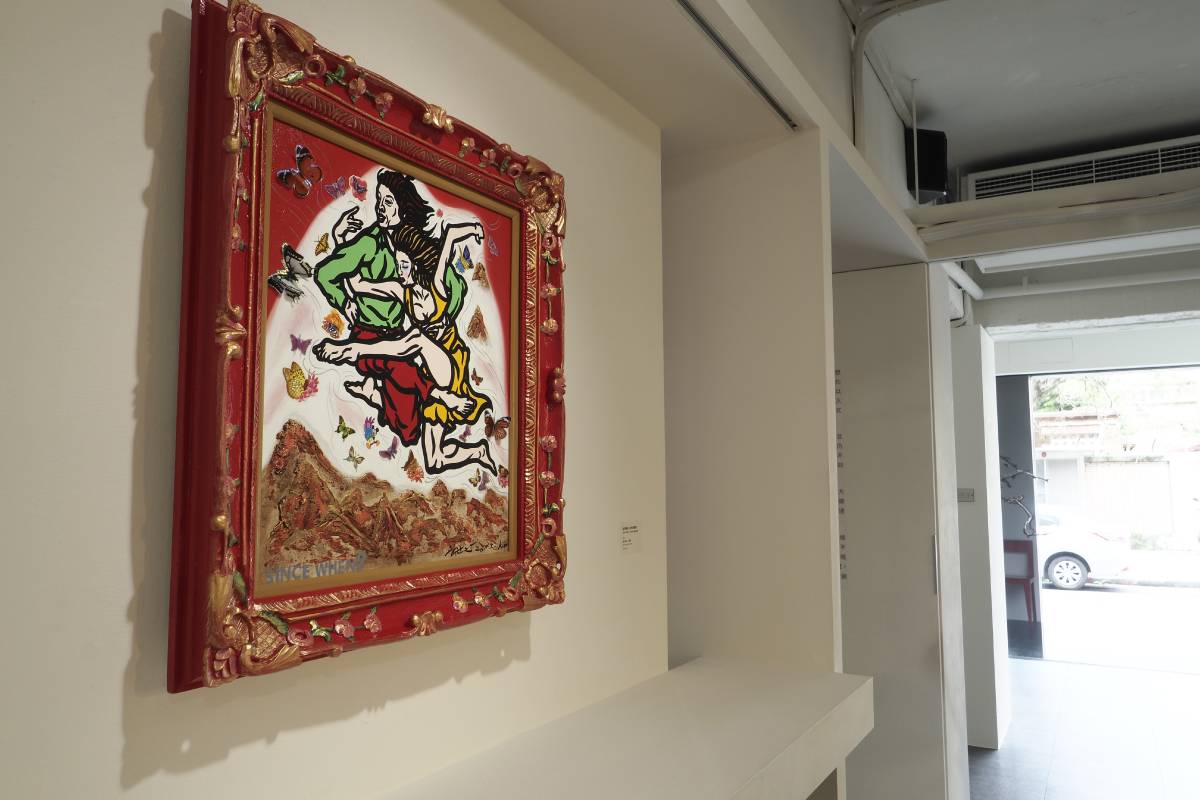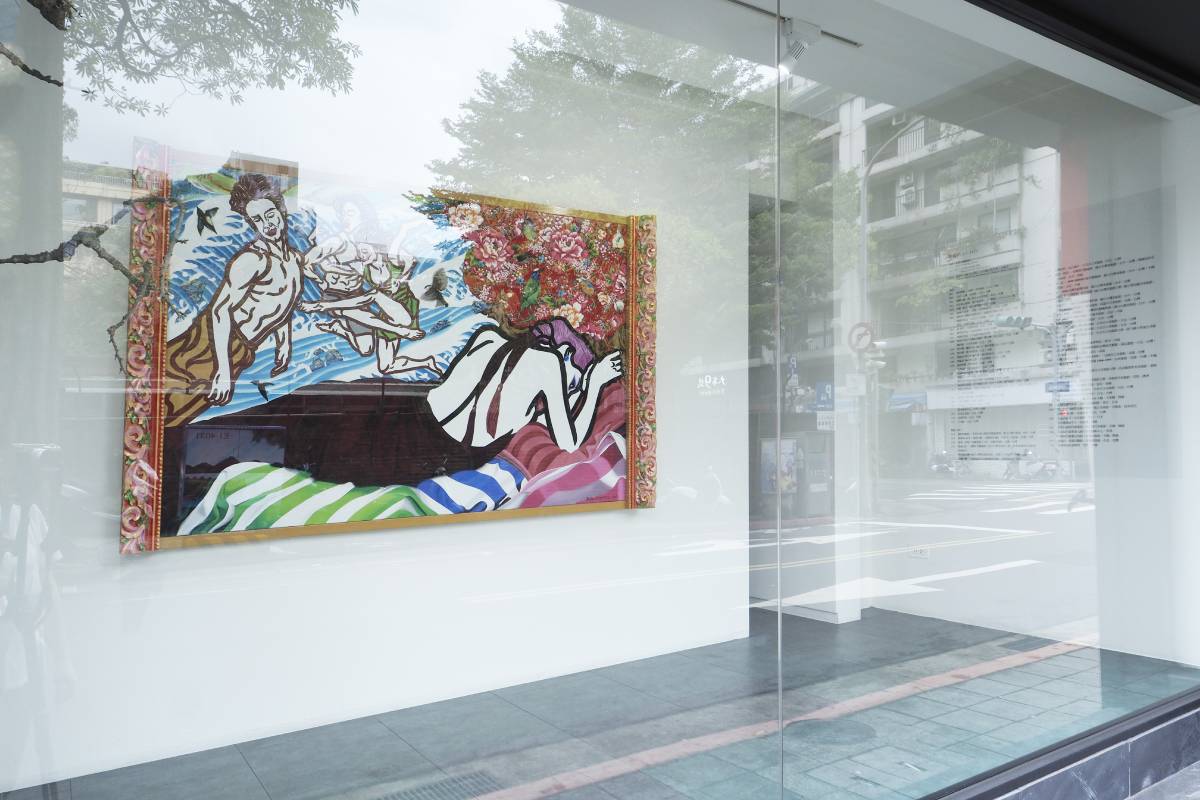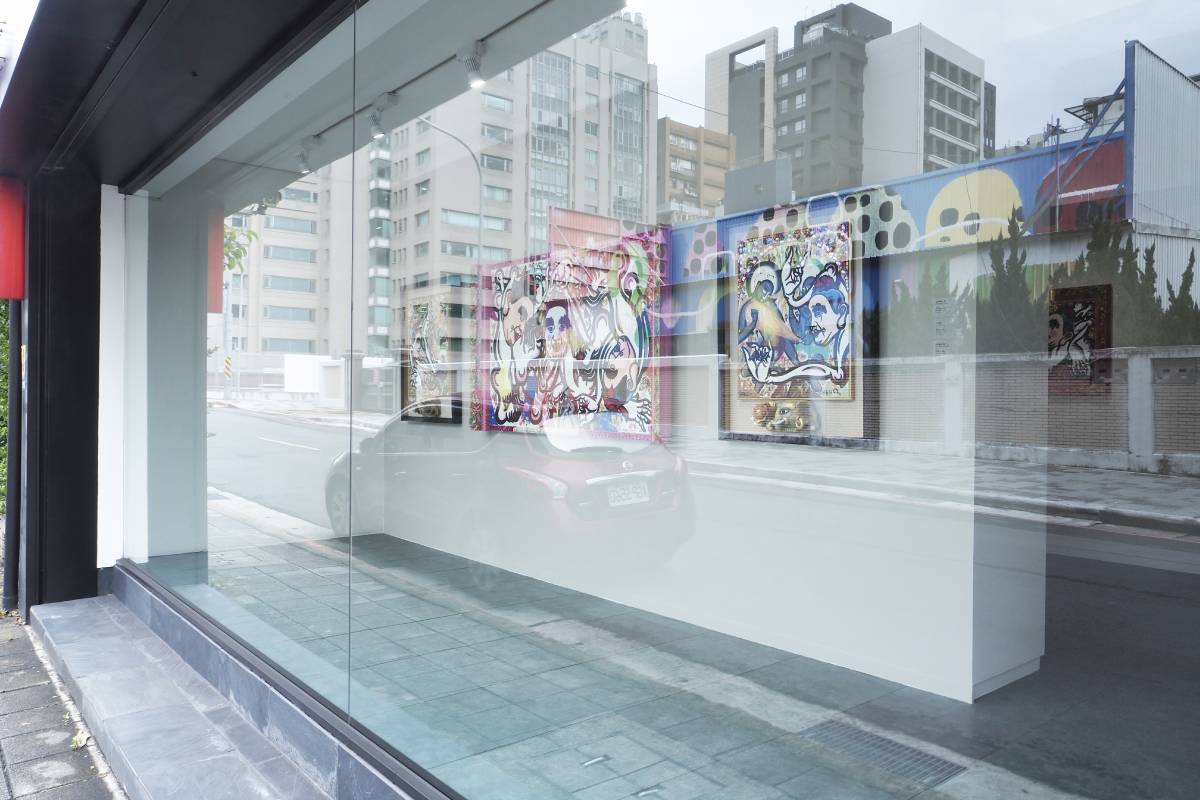赤粒藝術
【從何開始】啟動
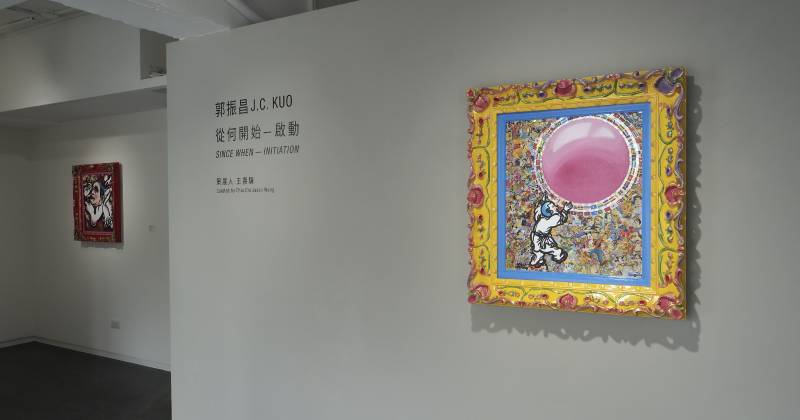
-
對立與混合:郭振昌的藝術
王嘉驥
25歲之前的郭振昌(1949年生),主要受現代藝術導師李仲生(1912-1984)啟蒙;後者以佛洛伊德心理學為基礎的教學法,帶給他深遠影響。從他1970年代前期的畫作看出,他有意融入夢境與潛意識底層的心象。他以抽象結合非幾何及半具象的變形人體,給人身體器官的聯想,譬如乳房、陰莖、女性子宮、想像的人體內臟等。郭振昌這類風格的表現,同時反映了李仲生對於超現實主義與抽象藝術的重視。
25歲以後的郭振昌,曾經獲得美國「亞洲基金會」(The Asia Foundation)的獎助,有過長達5年的時間,從1974年到1979年,在臺灣民間進行傳統手工藝的田野調查。 郭振昌以人類學者的研究態度,走進鄉土,體認藝術與生活、文化密不可分的一面。臺灣漢民族的傳統手工藝源自中國大陸,隨著先來後到的先輩移民落地傳衍;也有許多中國藝師應聘前來,留下駐臺期間的創作成果。透過傳統手工藝的流傳,郭振昌對於臺灣常民社會及其生活文化的本質與發展,有了深入了解。不僅如此,傳統工藝的造型語彙和母題也成為他日後創作擷取和挪用的對象。
1970年代的台灣遭逢接踵而至的國際政治逆境,反倒加速了現代化進程。為了發展工業,臺灣展開全面性的基礎建設。城市快速開發,勞動力向城市集中。城市與鄉村的生產模式迥異,生活形態尤有差距;現代化與傳統文化之間,很快出現扞格現象。同一期間,標榜反映社會,強調寫實主義風格的鄉土文學運動蔚為浪潮,藝術界隨之掀起一股鄉土熱;之後,更成為1980年代至1990年代的「本土化」論述之濫觴。目睹社會變遷,郭振昌曾於1977年撰文,發表他對「回歸鄉土」這一主張的反思。他指出,「工業文明」的侵襲下,「鄉村都市化的趨勢日益加速」,「新與舊」或「鄉土與現代」的「衝突」難以避免。
1979年,郭振昌以「生活寫實」之名發表個展,畫風轉向社會寫實。根據他的主張,「凡是能將現在生活的特質表現出來的,就是寫實。」透過繪畫創作,他有意「反映時代的誇張、不實及混亂。」 當時的臺灣,正處第三世界開發中國家的經濟狀態;不僅社會條件不足,家庭背景也無法支持他成為專職藝術家。從30歲到40歲的階段,郭振昌投身職場10年,讓他對臺灣的發展有了第一手認識。經貿活動蓬勃之外,政治的民主化與改革也是臺灣1980年代的重要議題。
1987年,已在商界多年的郭振昌,集結他1980年代期間,利用工作之餘所完成的作品,再次發表個展。儘管只能撥冗創作,部分畫作的完成度或許仍嫌不足,但他已經為個人往後的藝術形式與風格確立了基調。以稍早的生活寫實為基礎,他加入以強烈黑色線條勾勒的人形輪廓。寫實的摩登女性形象,搭配他從中國漢代畫像磚上挪用而來的男性武士、俠客、羽人之類的線描造形,營造古今並置的圖像。 除了寫實的形象與表現主義風格的黑色聳動線條,郭振昌還運用鮮豔、繽紛的平塗色彩,混搭動作性的抽象或半抽象筆觸,彰顯圖畫的張力。
運用傳統/現代、男性/女性、東方/西方、寫實/抽象等多層次的對照,郭振昌形塑了一種混合、對立,甚至衝突的意象。而這樣的視覺語法,為他後續的創作奠定了概念基礎。郭振昌畫作內蘊的另一個核心價值,就是他的創作觀照一直都聚焦在常民的生活與文化範疇。對於形象素材的取用,他始終都從通俗流行的文化或次文化當中去尋找。即使從藝術史的傳統擷取合適他運用的文化造型或符號,他也以反映民間生活禮俗及宗教信仰為主要對象。他還結合美國普普藝術(Pop Art)的概念,大量置入反映當代消費文化的圖像。以他畫中的女性為例,很多應該都是時尚雜誌常見的西方女模形象。尤其是1990年代以後,他開始以拼貼的手法,移植各式各樣的現成物,取材的來源更是反映現實生活與消費文化的商品。
40歲以後的郭振昌,毅然回歸專職藝術家身份。進入1990年代,他年年發表個展,維持了有連續10年之久。延續稍早已經明確的藝術風格,他進一步拓寬繪畫的主題及文化內涵。1992年,他專注研究神話,尤其是中國神話。誠如著名的神話學家所言,認清人皆有死,必須加以超越,這是神話生成的首要趨力。 神話反映一個民族或人類亙古以來共通的畏懼和欲望,以及人類在面對生命情境時,可能會有的各種行為模式。從榮格(Carl Gustav Jung, 1875-1961)心理學的角度來看,神話是人類集體潛意識(the collective unconscious)的一種再現。郭振昌從當代社會入手,連結中國神話的人物及敘事,創造了一套個人的造像學,用以詮釋臺灣獨特的文化現象。最具代表性的表現之一,就是他以巨人夸父逐日的悲劇故事為藍本,將其轉化,用以描述遍行世界,日以繼夜,戮力創造經濟奇蹟的各種臺灣人民。
回顧郭振昌1990年代以來的創作,表現個人特定或自我特殊情境與遭遇的主題,並不在他的關懷之列。相反地,他的觀照重點在於,發掘臺灣社會人心的深層心理結構。他在畫中並置紛雜的圖像與符號,勾喚歷史、記憶,或是反映當下處境的同時,也映照人性心理複雜且盤根錯節的狀態。1990年代期間,他時而選用一些通俗、不起眼,而且非藝術性的意象,甚至是現成品,譬如:時鐘、勳章與徽章、面具、花布、仿製的偽珠寶、反映時事的報紙等。 2000年以後,他把現成品的拼貼發揮得更為淋漓盡致,也有更多文化性的符號加入,包括:用以儲存數據的光碟和記憶卡、折射歷史與文化傳統的書法印刷品,以及從文具店買來的種類與花樣都極為紛繁的貼圖等。 這些圖像與符號除了指涉一個時代對於物質的需求、想望和追求,也意味並承載著許多歷史記憶。
就以文具店販售的貼圖為例,郭振昌至少從2002年開始運用,迄今仍是他作品中的重要元素。貼圖盛行於年幼世代,兼具裝飾、娛樂與審美功能。從他拼貼入畫的五花八門圖案來看,很大一部分與風行的美國、日本動漫文化有關,也有一些可能是爲了活化兒童的學習而開發。無論如何,這些貼圖對應著一個年代、時期,甚至世代的生活及物質文化。不同的流行看出不同的消費傾向,最終寫入年青世代的成長記憶,繼而累積並形塑為他們共同的文化經驗。
2001年,郭振昌以繪畫結合影像輸出,延伸他1994年曾經發表的《八家將》系列,以及1998年《聖臺灣》系列的形式,將作品擴大為高2.8米、寬16米的巨型畫面,並借用精神分析學創始者佛洛伊德(Sigmund Freud, 1856-1939)的經典著作《圖騰與禁忌》(1913),為該作命名。之後,他沿用相同名稱,發展出一系列的作品。直到2008年,他受邀在臺北市立美術館舉行階段性的大型回顧展,仍繼續以「圖騰與禁忌」作為展覽名稱。
佛洛伊德以澳洲土著部落為例,探究圖騰崇拜與禁忌制度這兩種規訓對原始民族維繫血脈及繁衍的深層意義。對原始民族而言,圖騰和禁忌的根源,都是為了保護族群自身的生存而設。在此心理基礎上,各種儀式、律法和社會——包括婚姻——習俗,隨之衍生;久而久之,集體性的欲望、認同、崇拜、壓抑,乃至於焦慮和恐懼等,深化為一種超穩定結構。 拓延圖騰與禁忌的原始語境,郭振昌觀察臺灣常民的儀式、禮俗或信仰,探溯長久以來共通的生活認同及文化記憶。同時,他也從臺灣社會族群的認同對立與緊張關係,體察人們基於生存的危機感,釋放出各種精神上的不安和憂懼。透過繪畫,他凸顯的是臺灣社會共有的集體心理欲望,而非表面的分裂或利害衝突。
2010年前後,郭振昌的畫面上開始出現「SINCE WHEN?」(意即「從何開始?」)的大寫英文字樣。表徵儒、道、佛三教的一些通俗圖像,譬如孔子、孟子、三太子、羅漢、菩薩、臥佛,以及敦煌佛窟壁畫的畫面,頻繁地並列在他的作品裡。同時,他繼續鋪墊大量的貼圖和仿珠寶等現成品,反映當代的物質生活。透過這些繽紛的形式和繁複的雕琢,郭振昌在華麗中展現精緻的同時,再度創造了一種概念上的弔詭。
臺灣社會以中國大陸先來與後到的漢族移民為多數,歷經幾百年來的發展,不同族群之間的生存矛盾與利益衝突屢見不鮮。郭振昌以圖像混合的手法,表達儒、道、佛三種文化傳統深植臺灣社會,已成多數人共有的信仰和價值。「從何開始?」作為修辭性的問語,實際是以臺灣為主體,反思作為一個移民社會,如何逐漸朝向文化上的混合與共生。
將具有多重對比性的視覺形象與文化符號,並置和壓縮在同一畫面之中,這是郭振昌繪畫最醒目的特色。他在畫面上匯聚看似不協調,甚至矛盾、衝突的形象元素,讓觀者感受目不暇接的強烈張力。完全不怕造成視覺上的違和之感,郭振昌大膽利用鮮豔、華麗、駁雜的形式。混合寫實與表現主義風格,他還大量運用現成物的拼貼,強化繪畫的立體質感。彷彿轉換成為一種高分貝的聲量,郭振昌的繪畫讓人感覺腦海嘎嘎作響,不斷地對著觀者的知覺和思路衝擊而來。
Opposition and Interfusion: The Art of J.C. Kuo
Chia Chi Jason Wang
Before the age of 25, J.C. Kuo (b. 1949) was principally inspired by his mentor in modern art Lee Chun-Shan (1912-1984), whose pedagogical methods based on Freudian psychology profoundly influenced him. Judging from his works of the early 1970s, he consciously incorporated dreamscapes and subconscious imagery into his art. He blended abstraction with non-geometric, semi-figurative distorted human forms, inviting associations with human organs, such as breasts, phalluses, uteruses, and imaginary human internal organs. Kuo’s style of expression also reflected Lee Chun-Shan’s focus on surrealism and abstract art.
After turning 25, Kuo won a grant from The Asia Foundation of the United States and for five years, from 1974 to 1979, he conducted field surveys of traditional Taiwanese handmade folk art. Adopting the research orientation of an anthropologist, Kuo personally entered rural areas and experienced art’s inextricable connections with life and culture. The traditional handicrafts of the ethnic Han Chinese people of Taiwan originated in mainland China and were disseminated by early immigrants wherever they settled in the order of their arrival. Many Chinese artisans came to Taiwan for employment, leaving behind the artworks they made during their stays in Taiwan. Through the heritage of traditional handicrafts, J.C. Kuo gained a deep understanding of Taiwan’s grassroots society and the nature and development of its way of life and culture. Moreover, the formal vocabulary and motifs of traditional handicrafts became the subject matter he would later adopt and appropriate.
In the 1970s Taiwan encountered a succession of political setbacks, while conversely also accelerating the pace of its modernization. To promote industry, Taiwan embarked on comprehensive basic infrastructure development. Cities quickly expanded, and labor power became concentrated in urban areas. The models of production in the city and the country were entirely different, and the ways of life hugely disparate. Very quickly, mutual incompatibilities emerged between modernization and traditional culture. During the same period, the Native Soil Literature Movement, which championed mirroring society in a realist style, was flourishing, and a “nativist fever” also arose in art circles. This would later become the origin of the discourse on “Taiwanization” that appeared in the 1980s and 1990s. In 1977, J.C. Kuo, always attentive to changes in society, wrote an article sharing his reflections promoting “returning to the land.” He asserted that with the invasion of “industrial civilization,” the trend toward “urbanization of the countryside is gathering pace with each passing day,” and that “conflict between new and old” or “between the native and the modern” was inescapable.
In 1979, Kuo held a solo exhibition titled “Life Realism,” pivoting his style in the direction of social realism. He declared, “Anything that can express the special qualities of contemporary life is realism.” In his paintings he aimed to “reflect the preposterous, unreal, chaotic state of the times.” Taiwan in those years was economically a Third World developing nation. Not only did society lack sufficient material conditions, but also Kuo’s own family background did not afford him the support needed to be a professional artist. From 30 to 40 years of age, Kuo spent a decade in the working world, and this gave him a first-hand understanding of Taiwan’s development. In addition to burgeoning foreign trade, the major issue in Taiwan of the 1980s was political democratization and reform.
In 1987, after having spent several years in the business world, Kuo gathered together the artworks he had completed outside of work hours during the 1980s and held another solo exhibition. Even though he could only make art in the midst of a busy schedule and some of his works were perhaps not fully fleshed out, he nonetheless established a tone that would serve as the foundation for his future artistic form and style. Based on his slightly earlier “life realism,” he added the contours of human figures with bold black outlines. Realistic images of modern women, in conjunction with the linear forms of male warriors, swordsmen and winged anthropomorphic figures appropriated from Chinese pictorial tiles from the Han dynasty, produced images juxtaposing the ancient and the contemporary. In addition to realistic imagery rendered with flamboyant black lines in an expressionist style, Kuo also painted vibrant, effusive colors with flat surfaces, in a mixture of abstract or semi-abstract brushstrokes with a sense of motion, highlighting the tension in his pictures.
Employing multiple layers of contrasts—traditional/modern, male/female, East/West, representational/abstract—Kuo shaped imagery of interfusion, opposition and even conflict. And this visual vocabulary laid the conceptual foundation for his subsequent art. Another intrinsic core value in Kuo’s paintings was that his creative concern always focused on folk life and folk culture. He consistently drew the material for his images from popular culture or various subcultures. Even though he adopted cultural forms or symbols from the traditions of art history that were suitable for his use, his subject matter still principally reflected the lives, customs and religious faith of ordinary people. He also incorporated the concepts of American Pop art, inserting an abundance of images that reflected contemporary consumer culture. For example, many of the women in his paintings were images of female models often seen in fashion magazines. Especially beginning in the 1990s, he began to use collage to transplant a wide variety of readymades. The sources of this material were products reflecting real life and consumer culture.
After he turned 40, Kuo returned with determination to the life of a professional artist. In the 1990s he held a solo exhibition every year, maintaining this pace for 10 consecutive years. Extending from his earlier artistic style, which had become very clear, he went on to further expand the themes and cultural substance of his paintings. In 1992 he focused on studying myths, especially the myths of China. As one renowned mythologist wrote, the “recognition of mortality and the requirement to transcend it” is “the first great impulse to mythology.” Since antiquity, myths have always reflected the fears and desires common to a people or all humankind, as well as the possible ways that people may act when facing situations in life. According to the psychologist Carl Gustav Jung (1875-1961), myths are a manifestation of the collective unconscious. Starting with his observations of contemporary society, Kuo forged connections with figures or narratives from Chinese myths, creating his own iconography, which he used to interpret the unique social phenomena of Taiwan. One of his most representative motifs was the tragedy of the Giant Kuafu Who Chased the Sun, which he used as a blueprint, transforming it into depictions of Taiwanese people traveling around the globe, working diligently day and night to forge an economic miracle.
In his artworks since the 1990s, Kuo has shown scant concern about themes expressing individually specific or self-oriented scenarios or encounters. On the contrary, his observations have focused on exploring the deep psychological structure of Taiwanese society. He juxtaposes a complex melange of images and symbols in his paintings to evoke history and memory or to reflect the current situation, while also reflecting humanity’s complex and tangled condition. During the 1990s, he sometimes chose to use commonplace, unremarkable, non-artistic images, even readymade products such as clocks, medals, badges, masks, floral-patterned cloth, ersatz jewelry, and newspapers referencing current events. In the 2000s, he gave more unrestrained expression to his readymade collages, while inserting more cultural symbols, including: optical discs or memory cards used to store data, calligraphy prints reflecting history or cultural traditions, and stickers of wildly diverse types and patterns purchased at stationery stores. These images and symbols not only referenced the material needs, hopes and pursuits of the times, but also implied and conveyed many historical memories.
For example, stickers from stationery stores, which Kuo began using at least by 2002, have remained a major element in his artworks to this day. Highly popular with the young generation, stickers have decorative, entertaining and aesthetic functions. Among the panoply of images he has incorporated into his collages, many seem related to the culture of comic books and animation prevalent in America and Japan, while others seem to have been developed to activate children’s learning abilities. In any case, these stickers correspond to life and material culture in a certain era, a time period, or even a generation. Different trends lead to different consumption habits, which are eventually written into the young generation’s memories of growing up, then build up and take shape as their common cultural experience.
In 2001, Kuo produced a huge work 2.8 meters tall and 16 meters wide combining painting with digital prints, which extended his Eight Generals series of 1994, as well as the forms he explored in his 1998 series St. Taiwan. He christened it Totem and Taboo, a title he borrowed from the classic 1913 text by Sigmund Freud (1856-1939), the founder of psychoanalysis. Afterward, he continued to use the same title in a whole series of artworks. In 2008, he was invited by Taipei Fine Arts Museum to hold a large-scale retrospective presenting the various stages of his artistic development, and he continued to use Totem and Taboo as the exhibition title.
In his book, Freud cited Australian indigenous people as an example, exploring the profound significance that primitive peoples place in totemic ritual and taboo systems as forms of discipline in order to maintain bloodlines and reproduction. For primitive peoples, the root of totems and taboos is protecting the survival of the ethnic group itself. Various rituals, laws and social customs, including marriage, are derived from this psychological foundation. Over time, collective desire, identification, adoration, repression, and even anxiety and fear deepen to form a highly stable structure. Continuing with the primitive vocabulary of totem and taboo, Kuo observed the rituals, customs and religious practices of ordinary Taiwanese people, digging into their sense of identity in daily life and their cultural memories long held in common. He also addressed the opposing identities and tense relations among different ethnicities in Taiwanese society, examining the many forms of psychic disquiet and apprehension released by people based on feelings that their survival was imperiled. What he highlighted in his paintings was the collective psychological desires of Taiwanese society, not superficial schisms or conflicts of interest.
Beginning in 2010, the English words “SINCE WHEN?” began to appear in Kuo’s pictures in full capital letters. Numerous commonly seen images representing the three religions of Confucianism, Taoism and Buddhism were continually lined up side by side in his works—Confucius, Mencius, the Taoist immortal Nezha, Buddhist saints, bodhisattvas, the Reclining Buddha, and the Buddhist murals from the caves of Dunhuang. He also continued to inlay his pictures with large quantities of stickers, fake jewels and other readymades, reflecting contemporary material life. Through these riotous forms and complex sculptings, elaborate yet exquisite, Kuo once again created statements that were conceptually paradoxical.
The majority of Taiwanese society are Han Chinese immigrants from mainland China, some who arrived earlier, some later. After centuries of development, contradictions in ways of life and conflicts of interest between different ethnic groups have often taken place. Through his method of fusing images, J.C. Kuo has expressed how the Confucian, Taoist and Buddhist cultural traditions have sunk deep roots in Taiwanese society, becoming the common faiths and values of most people. “Since When?” serves as a rhetorical question. In fact, its subject is Taiwan, and it muses on how this immigrant society can gradually move towards cultural merger and symbiosis.
The juxtaposition and compression of multiple contrasting visual images and cultural symbols in the same picture is the most striking feature of J.C. Kuo’s paintings. On his canvasses, seemingly disjointed, even contradictory, conflicting visual elements converge, making the viewer feel such powerful tension that the eye cannot absorb it all. Completely unafraid of creating a sense of visual cacophony, Kuo boldly uses vibrant, lavish, kaleidoscopic forms. Mixing realistic and expressionist styles, he employs copious collages of readymade objects to fortify the three-dimensional texture of his paintings. As if transformed into a high-decibel sound, Kuo’s paintings make the mind resonate to the point of shattering, constantly impacting the viewer’s perception and thoughts.
推薦展覽
view all赤粒藝術
【遠山疎樹李茂成個展】Scattered Trees and Distant Mountains: Solo Exhibition of LEE Mau-cheng
日期:2024-06-22 ~ 2024-08-04|台灣,台北市
赤粒藝術
【自然與記憶梁兆熙2024個展】Nature and Remembrance: Solo Exhibition of LIANG Zhaoxi
日期:2024-05-04 ~ 2024-06-16|台灣,台北市
